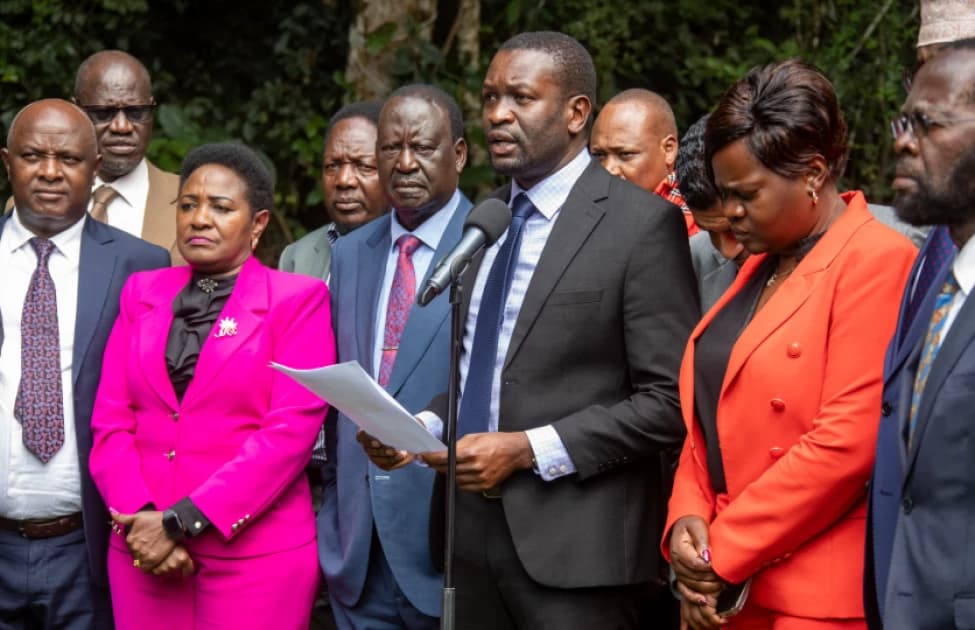Loading News Article...
We're loading the full news article for you. This includes the article content, images, author information, and related articles.
We're loading the full news article for you. This includes the article content, images, author information, and related articles.
Nandi Senator Samson Cherargei has called for the immediate removal of Nairobi Senator Edwin Sifuna as the Orange Democratic Movement (ODM) Secretary General, accusing him of undermining the party's alignment with President William Ruto's administration.

Nandi Senator Samson Cherargei, a prominent ally of President William Ruto's United Democratic Alliance (UDA) party, publicly demanded the removal of Nairobi Senator Edwin Sifuna from his position as ODM Secretary General. Speaking on Sunday, October 19, 2025, shortly after the burial of former Prime Minister Raila Odinga in Bondo, Siaya County, Cherargei accused Sifuna of actively sabotaging ODM's political trajectory and undermining its collaboration with the broad-based government.
Cherargei asserted that while the majority of ODM leadership had embraced working with President Ruto's administration, Sifuna remained a defiant voice, openly questioning the alignment. The Nandi Senator labelled Sifuna as "the biggest threat to ODM's growth" and an "opposition mole" within the party, urging the ODM leadership to dismiss him before the end of 2025.
The call for Sifuna's ouster underscores a deepening ideological rift within ODM concerning the party's future direction and its relationship with the Kenya Kwanza government. Following Raila Odinga's passing on Wednesday, October 15, 2025, from cardiac arrest in India, various ODM leaders have offered differing interpretations of his final instructions regarding cooperation with President Ruto.
Homabay Governor Gladys Wanga, who also serves as the ODM National Chairperson, stated at Odinga's funeral that the late leader's clear directive was for the party to continue working with President William Ruto's administration for national stability and unity within a broad-based government. This sentiment was echoed by other ODM leaders, including Cabinet Secretaries John Mbadi, Hassan Joho, Opiyo Wandayi, and Wycliffe Oparanya, who affirmed their commitment to remaining in the broad-based government, citing Odinga's wishes.
However, Senator Sifuna presented a contrasting view, emphasizing the need to preserve ODM's independence and unity. He stated that Odinga, just 23 days before his death, had instructed the ODM party to prepare for the 2027 general elections. Sifuna vowed to protect the party from internal divisions and to uphold Odinga's legacy by ensuring ODM remains a strong, united political force.
The current cooperation between ODM and the ruling UDA stems from a Memorandum of Understanding (MoU) signed by President William Ruto and former Prime Minister Raila Odinga on Friday, March 7, 2025, at the Kenyatta International Convention Centre (KICC) in Nairobi. This agreement aimed to ease political tensions, foster national unity, and address socio-economic challenges in Kenya. Key aspects of the MoU included the full implementation of the National Dialogue Committee (NADCO) report, addressing youth unemployment, and promoting inclusivity.
While the MoU was intended to bring political stability, it has also exposed internal friction within ODM. Some members, particularly a youthful faction, have criticised the alignment as a betrayal of ODM's reformist legacy. Senator Sifuna himself has previously questioned the legitimacy and implementation of the MoU, particularly in light of ongoing concerns about police brutality and the loss of lives during protests.
The Orange Democratic Movement operates with a democratic structure, from national to grassroots levels, designed to ensure member participation in governance and decision-making. The National Delegates Convention (NDC) is the highest decision-making organ, meeting every five years to elect leadership and ratify policies. The National Executive Committee (NEC) manages day-to-day affairs, while the Party Parliamentary Group (PPG) coordinates the legislative agenda.
The current debate highlights a tension between party loyalty and individual interpretation of political directives. While some ODM leaders serving in government, such as CS John Mbadi and CS Hassan Joho, have reaffirmed their commitment to the broad-based government, Sifuna has maintained his stance on preserving ODM's distinct identity and preparing for future elections.
The public disagreement within ODM risks further fracturing the party, potentially weakening its political standing ahead of the 2027 General Election. President Ruto has pledged his support for a strong and united ODM, hinting at a possible coalition with UDA in 2027, and has warned against efforts to break the party. However, the divergent views on cooperation with the government could lead to internal disciplinary actions or even defections, as seen in past political realignments.
The central controversy revolves around the precise nature of Raila Odinga's final political instructions. While some leaders claim he unequivocally directed ODM to work with the broad-based government, Sifuna maintains that Odinga's last directive was to prepare for the 2027 elections. This ambiguity leaves room for varied interpretations and potential power struggles within the party as it navigates a post-Odinga era. The long-term implications of the ODM-UDA MoU, particularly concerning its duration and scope beyond 2027, also remain a point of contention.
Observers will be closely watching for any official statements or actions from the ODM National Executive Committee regarding Senator Sifuna's position and the broader question of the party's alignment with the Kenya Kwanza administration. The unity and strategic direction ODM takes in the coming months will significantly influence Kenya's political landscape leading up to the 2027 General Election.
Keep the conversation in one place—threads here stay linked to the story and in the forums.
Other hot threads
E-sports and Gaming Community in Kenya
Active 6 months ago
Popular Recreational Activities Across Counties
Active 6 months ago
The Role of Technology in Modern Agriculture (AgriTech)
Active 6 months ago
Investing in Youth Sports Development Programs
Active 6 months ago